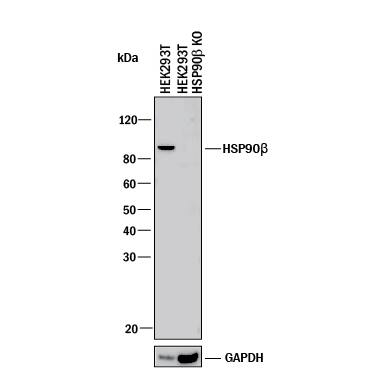Human/Mouse/Rat HSP90 beta Antibody
R&D Systems, part of Bio-Techne | Catalog # MAB32861

Key Product Details
Validated by
Species Reactivity
Applications
Label
Antibody Source
Product Specifications
Immunogen
Met1-Asp724
Accession # P08238
Specificity
Clonality
Host
Isotype
Scientific Data Images for Human/Mouse/Rat HSP90 beta Antibody
Detection of Human/Mouse/Rat HSP90 beta Isoform by Western Blot.
Western blot shows lysates of Raji human Burkitt's lymphoma cell line and HeLa human cervical epithelial carcinoma cell line, CH-1 mouse B cell lymphoma cell line, A20 mouse B cell lymphoma cell line, and L6 rat myoblast cell line. PVDF membrane was probed with 0.25 µg/mL Mouse Anti-Human/Mouse/Rat HSP90 beta Monoclonal Antibody (Catalog # MAB32861) followed by HRP-conjugated Anti-Mouse IgG Secondary Antibody (Catalog # HAF007). For additional reference, recombinant human HSP90a and HSP90 beta (5 ng/lane) were included. A specific band for HSP90 beta was detected at approximately 100 kDa (as indicated). This experiment was conducted under reducing conditions and using Immunoblot Buffer Group 2.Western Blot Shows Human HSP90 beta Specificity by Using Knockout Cell Line.
Western blot shows lysates of HEK293T human embryonic kidney parental cell line and HSP90 beta knockout HEK293T cell line (KO). PVDF membrane was probed with 0.25 µg/mL of Mouse Anti-Human/Mouse/Rat HSP90 beta Monoclonal Antibody (Catalog # MAB32861) followed by HRP-conjugated Anti-Mouse IgG Secondary Antibody (Catalog # HAF018). A specific band was detected for HSP90 beta at approximately 90 kDa (as indicated) in the parental HEK293T cell line, but is not detectable in knockout HEK293T cell line. GAPDH (Catalog # MAB5718) is shown as a loading control. This experiment was conducted under reducing conditions and using Immunoblot Buffer Group 1.Applications for Human/Mouse/Rat HSP90 beta Antibody
Knockout Validated
Western Blot
Sample: Raji human Burkitt's lymphoma cell line and HeLa human cervical epithelial carcinoma cell line, CH-1 mouse B cell lymphoma cell line, A20 mouse B cell lymphoma cell line, and L6 rat myoblast cell line
Formulation, Preparation, and Storage
Purification
Reconstitution
Formulation
Shipping
Stability & Storage
- 12 months from date of receipt, -20 to -70 °C as supplied.
- 1 month, 2 to 8 °C under sterile conditions after reconstitution.
- 6 months, -20 to -70 °C under sterile conditions after reconstitution.
Background: HSP90 beta
HSP90 is a composite name for a large group of Heat Shock Proteins whose molecular weights average 90 kDa. HSPs function primarily as a molecular chaperone, facilitating the folding of other cellular proteins, preventing protein aggregation, or targeting improperly folded proteins to specific degradative pathways. HSP90 is a central component in a number of basic cellular processes including hormone signaling and cell cycle control. HSP90 is ubiquitously expressed, highly conserved and accounts for 1-2% of the total cellular protein. Recently introduced, standardized nomenclature has divided the 17 identified HSP90 genes into three related and one unrelated classes, HSP90AA, HSP90AB, HSP90BB, and TRAP, respectively. Eukaryotic cells have two principal isoforms of HSP90. The antibody described here reacts with the constitutively expressed, 724 amino acid, HSP90AB1-isoform 1 (also known as HSP90 beta, HSP90B, HSPCB, HSPC2, and HSP89 beta). The inducible form, HSP90AA1, is a 737 amino acid protein (also known as HSP90 alpha, HSP90A, HSPC1, HSPCA, HSP89 alpha and LAP2). HSP90AB1-1 and HSP90AA share 90% identity.
Long Name
Alternate Names
Entrez Gene IDs
Gene Symbol
UniProt
Additional HSP90 beta Products
Product Documents for Human/Mouse/Rat HSP90 beta Antibody
Product Specific Notices for Human/Mouse/Rat HSP90 beta Antibody
For research use only

